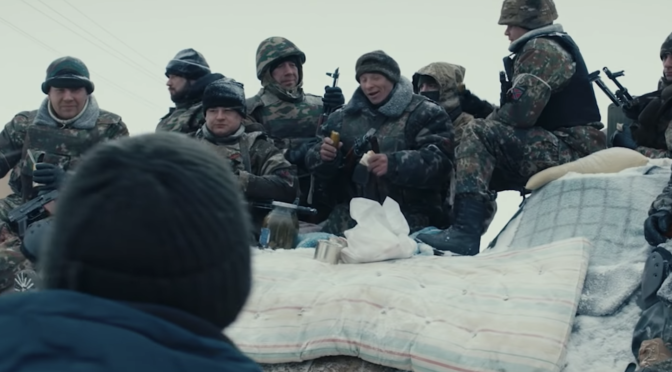The war in Ukraine has been raging for over five years now, but the West seems to have forgotten about it. New issues – first the migrant crisis, then Brexit and Trump – have come to dominate the news cycle. Ukrainian director Sergei Loznitsa’s DONBASS plays an important role, therefore, in reminding us of this ongoing, brutal conflict. Loznitsa deservedly took home the award for Best Director in the ‘Un Certain Regard’ category of the 2018 Cannes Film Festival for DONBASS.
The two-hour film manages to be both stately and understated, conveying the verisimilitude of a documentary, and it should come as no surprise that Loznitsa is also a documentary maker. He utilises a number of different techniques, from static camera to handheld, with each scene feeling new, but he also relates them to what has come before. DONBASS essentially comprises a series of interconnected vignettes, all set in the occupied territory in eastern Ukraine.
Make no mistake: DONBASS is not a war film and there are few scenes of fighting. Instead, this is a film about a country torn apart by conflict, both military and social. The corruption of politicians is brought up, but Loznitsa is far more interested in the ugliness that results within everyday life. We see Ukrainians in a cramped bus, for instance, every one of them affected in some way by the conflict. The men on the bus are mocked by a female soldier for not enlisting and are forced, in the snow, to strip to the waist.
Elsewhere in the film, a German journalist is insulted because of his nationality, which according to the separatist soldiers makes him a fascist, like those in western Ukraine. We also meet the inhabitants of a dank city bomb shelter, which has no heating and no working toilet. Because of its focus on the ordeals of those at the bottom of society, DONBASS could be classified as an example of social realism.
In its most brutal scene, a Ukrainian soldier is tied to a post and vilified as an ‘extermination squad volunteer’. Members of the public are encouraged to insult and even attack him, which they eagerly do, blaming this man – who claims to have only been a cook – for the deaths of their friends and relatives. This is then followed by the film’s lightest scene, the comical and very boisterous wedding of ‘Mr and Mrs Fried-Egg’. After this, however, it is back to the bleak reality of war and devastation.
Although masterful in its depiction of ordinary life, DONBASS is likely to prove confusing for viewers less familiar with the ins-and-outs of the war in Ukraine – many, for instance, will not know the history behind the concept of Novorossiya (or ‘New Russia’), which plays a central role in the film, and little contextualisation is provided. The politics of language is also crucial in the Ukraine-Russia conflict, but unless knowledgeable of one or both languages, viewers probably won’t be able to distinguish between dialogue spoken in Ukrainian and dialogue spoken in Russian.
DONBASS, which is an international co-production and received funding from France, Germany and the Netherlands, is certainly positioned against the separatist forces in Ukraine and I can’t speak for its accuracy. Nevertheless, I would urge those who want to learn more about this European conflict to watch DONBASS for that reason, just as much for its achievements from a filmmaking perspective. Its power lies not in explosions and gunshots, but in its depiction of the suffering of millions of Ukrainians that continues to this day.

